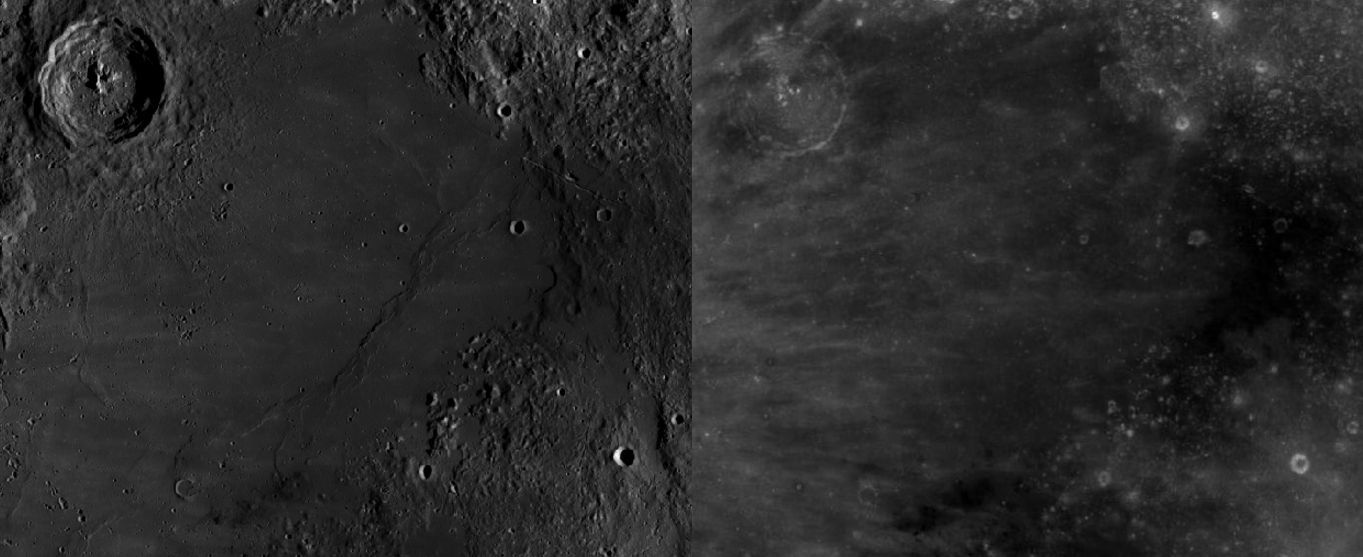Sinus Aestuum
Contents
Sinus Aestuum
|
Lat: 12.19°N, Long: 6.62°W, Diam: 316.5 km, Depth: km, [/R%C3%BCkl%2032 Rükl: 32] |

Sinus Aestuum in the local morning (left) and local noon (right). LRO
Images
LPOD Photo Gallery Lunar Orbiter Images Apollo Images
- Apollo 12's Hasselblad photograph AS12-50-7434 shows an oblique northward view of Sinus Aestuum's eastern part (foreground) with bowl-shaped craters [/Bode Bode] C and H, and the [/Montes%20Apenninus Montes Apenninus] below centre of the image. Research Danny Caes
- Apollo 17's Nikon photograph AS17-160-23946 shows a north-south oriented view of Sinus Aestuum (mentioned as Seething Bay) east of [/Eratosthenes Eratosthenes] (right margin). Part of [/Montes%20Apenninus Montes Apenninus] is seen at the image's lower half. Research Danny Caes
Maps
([/LAC%20zone LAC zone] 59A4) LAC map Geologic map
Description
Wikipedia
Additional Information
- IAU page: Sinus Aestuum
- Mare area of 39,600 km^2 according to measurements by Jim Whitford-Stark.
- LROC view of dark mantled deposits around Sinus Aestuum region.
Nomenclature
- Sinus Aestuum was part of the original IAU nomenclature of [/Blagg%20and%20M%C3%BCller Blagg and Müller] (1935).
- Section of the Face of the Woman in the Moon.
- Section of Ed Murray's C or Dark C.
- The name Sinus Aestuum is Latin, according to the IAU, for "Seething Bay", or according to [/Whitaker Whitaker], "Bay of Seething Heat" (p. 87) or "Bay of Hot Days" (p. 216).
- In a review of their book in the February 1955 [/BAA JBAA] (page 121), Whitaker criticizes [/Wilkins%20and%20Moore Wilkins and Moore] for translating the name as "Bay of Heat," saying the correct translation is "Bay of Billows."
- According to Whitaker (pp. 216-217), this name was introduced by [/Riccioli Riccioli], although Riccioli used it for the feature now known as [/Sinus%20Medii Sinus Medii]. Blagg, in her [/Collated%20List Collated List] (#1270), found the present feature labeled with its modern name by all the authorities she consulted. Whitaker does not specify who moved it to its present location.
- [/Langrenus Van Langren] had previously referred to this area (plus [/Mare%20Vaporum Mare Vaporum]) as Fretum Catholicum ([/Whitaker Whitaker], pp. 192 and 200).
- Aestuum Pyroclastics, an unofficial name on chart 17 of the 21st Century Atlas of the Moon (C.A. Wood/ M. Collins). The location of the Aestuum Pyroclastics is north-northwest of Schroter, at the same location of F.v.P. Gruithuisen's so called "lunar city".
LROC Articles
A Path Not Taken
DMD Excavations
Pyroclastic Trails
Striped Crater
LPOD Articles
What's happening at Aestuum? A radial section of debris
Lunar 100
- [/Lunar%20100 L79]: Eastern dark-mantle volcanic deposit.
Bibliography
Wood, C.A. 8/2005. Pyroclastics on the Moon. S&T 110(2):62-63
[/Alphabetical%20Index Named Features] -- Prev: [/Lacus%20Aestatis Lacus Aestatis] -- Next: [/Promontorium%20Agarum Promontorium Agarum]
This page has been edited 1 times. The last modification was made by - tychocrater tychocrater on Jun 13, 2009 3:24 pm - afx3u3